
Publisher:
Bonnie King
CONTACT:
Newsroom@Salem-news.com
Advertising:
Adsales@Salem-news.com

~Truth~
~Justice~
~Peace~
TJP
Aug-03-2014 01:00

 TweetFollow @OregonNews
TweetFollow @OregonNews
The Diane Downs' Case Was No Small Sacrifice
Lise LaSalle special to Salem-News.comThe Diane Downs case is a notorious piece of Oregon crime history. But was justice served? Not by today's standards.
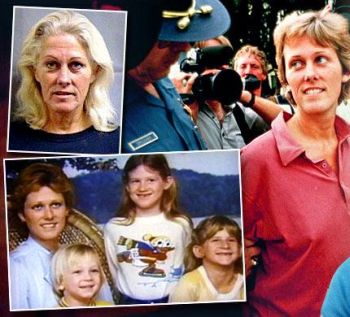 Diane Downs has served over 30 years for a crime she vows not to have committed. |
(British Columbia) - On May 19, 1983, Elizabeth Diane Downs and her three small children were shot on a country road near Springfield, Oregon. Her 7-year old daughter Cheryl died, but her 3-year old son Danny and her 8-year old daughter Christie survived.
Within three weeks, Diane had lost custody of her remaining wounded children and had become the number one suspect in the eyes of the police department and District Attorney’s office.
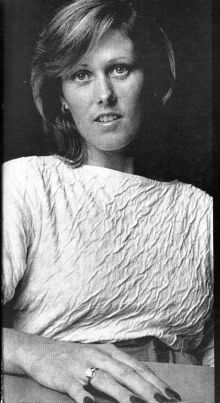 Diane Downs |
This case flew under my radar so to speak because it happened before my ‘time’. I had nonetheless heard of the legendary Diane Downs; the cruel sociopath who had sacrificed her own children to be free to pursue a relationship with the man she loved. I must humbly admit that I had not questioned the facts of the case before readily accepting this image of Diane as a cold blooded killer.
I know better now than to accept blindly the truth presented to us on a silver platter by the media and the judicial system.
Having recently done research on the Liysa Northon’s case which was the subject of a book written by Ann Rule titled Heart Full of Lies, I came across some very interesting information about the Diane Downs case because Rule attended the trial and also wrote a book about the case called Small Sacrifices.
In reality, the whole case turned out to be no small sacrifice for Diane Downs, but it was a huge victory for the State, the media and a very lucrative deal for the Queen of crime fiction herself: Ann Rule.
In her book Heart Full of Lies, Rule took so many liberties with the facts that Liysa Northon sued her. It opened a huge can of worms regarding the real identity of the heart full of lies in this case. Some 287 errors and falsehoods were documented by Liysa and verified by official sources. Rule sued the Seattle Weekly after they published the article titled "Ann Rule’s Sloppy Storytelling," but she lost and had to make restitution.
The popular TV movie “Small Sacrifices” was based on Ann Rule’s book and it painted a horrid picture of the mother accused of shooting her children on Old Mohawk Road. The role of Diane Downs was played by none other than Farrah Fawcett and her lover was played by Ryan O’Neal who had been Farrah’s love interest in real life.
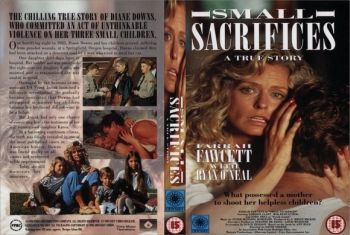
They brought out the big guns to unload on the public, their idea of the truth: Diane Downs was a horrible creature and a jilted lover who shot her three children in cold blood to be free to pursue a relationship with the man she was obsessed with.
My opposition to movies about true crime stories is unshakable. It should be illegal to use real names and facts from a criminal case while influencing the public to falsely believe that the whole content of the film is true. The Lifetime channel constantly makes movies based loosely on the truth; this approach is an effective weapon aimed at swaying public opinion about high-profile cases.
Ann Rule promotes her books as true crime stories so to this day, viewers believe that the book and the movie titled Small Sacrifices document the true story of the Diane Downs’ case; in fact, it is a mix bag of truth, falsehoods, interpretation and plain fiction.
Diane Downs
Diane Downs was born August 7, 1955 in Phoenix, Arizona. Her parents Willadene and Wes were old school Baptist parents who raised her under strict guidelines without much warmth but with complete devotion.
Diane was known for her love of all animals which she treated with great care, and for her independent and wild streak. She was extremely intelligent but her emotional IQ was no match and her desire for freedom, love and affection were dangerously dragging her down a path of self-destruction.
In high school, she met handsome Steven Downs who saw her for the great beauty she had become. Growing up, Diane had felt like an outsider and kids had been cruel towards her because of her real or imagined ugly duckling looks and demeanor. She did not fit in and was now anxious to assert her independence and live her own life.
Steven, Diane and kids in Arizona |
She learned at a young age to keep her emotions in check and to always present a strong and brave front. That is the way she was brought up, especially at the demand of her rigid but very dedicated father.
After graduation, Steven joined the Navy and Diane was sent to Pacific Coast Baptist Bible College where she failed miserably at remaining pure and chaste, not unlike most girls of her generation who rejected their strict religious upbringing. She was expelled and reunited with Steven against her parents’ wishes. They had dreamt of a good future for their daughter and Steven was not part of it.
Steven and Diane married on November 13, 1973. She was eighteen and soon realized that she had jumped from the fire into the frying pan. Her quest for love had landed her into an unstable and loveless marriage. Her husband turned out to be a player and a very irresponsible guy who did not really love her.
So Diane did what she thought would bring her the deepest satisfaction in life; she became a mother. She felt fulfilled when she was pregnant because she believed it was the road to unconditional love. Christie was born in October 1974 and Cheryl Lynn in January 1976.
This unhealthy marriage survived and became a daily struggle. Diane ran away from her husband many times between 1976 and 1977, but with nowhere to go except her parents’ house, she would come back. And Steven would hunt her down anyway and charm his way back into her life. It was the story of two young people trying to survive without a safety net.
In 1979, Diane gave birth to Danny who was not the biological son of Steven who had no desire to be a father again. As usual, Diane had resorted to the soothing comfort of a pregnancy to pretend life would get better; she would create a nest around her come hell or high water. And Steven was free to follow her lead or not. Surprisingly, he accepted little Danny and learned to love him dearly. But the birth of this little boy did not make this bad boy change his stripes; he remained a cad and a destabilizing force in their lives.
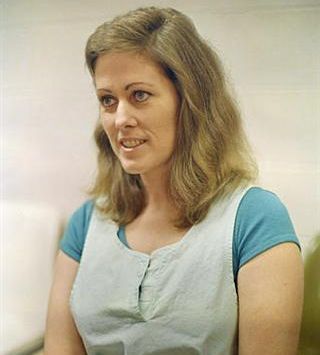
Finally, Diane found a full-time job with the U.S. Post Office in 1981, and was stationed in Chandler. She had always been the bread winner and never wavered in her desire to bring financial stability to her family. She even became a surrogate mother to make money and provide two parents the opportunity to have a child. She entertained the idea of opening a surrogacy agency but the project never really took off. This was ridiculed countless times in the media, but frankly, it can be a very honorable endeavor, depending on how you want to look at it.
In Rule’s book, Diane is portrayed as a horrible selfish mother but her family and friends saw another version; she loved her children dearly and worked hard to be a good provider. She was the first to admit that at times, she yelled too much and was not the best mother but she seemed to have turned the corner and was doing her best with the means at her disposal. From all accounts, her children adored her.
Diane, of her own admission, had plenty of affairs while she worked at the Post Office. And Robert Knickerbocker became one of her lovers. He actually was the one who suggested they become intimate after many friendly, platonic conversations. As a married man, the ball was in his court and he decided to go for it.
Diane found with him, the kind of relationship she had never known before: there was actually care and intimacy involved. Robert and Diane even decided to get matching tattoos. He separated from his wife and was going to follow Diane who, by now, had decided to move and work in Oregon to be closer to her parents. What followed was a tragedy subject to many interpretations.
The Move to Oregon
If there was one thing Diane knew about her lover, is that he was fickle and did not like trouble of any kind. After asking her to have an affair, he kept vacillating between his wife and her. He strung her along, played with both women’s emotions, and after saying he would join her in Oregon, reneged and stayed with his wife. Moreover, he told her that he did not want her children or any children for that matter. This statement alone would seal Diane’s fate.
After six weeks in Oregon where the children were happily spending time with their grandparents while Diane worked her postal route, the incident happened on a dark road that led to Diane being accused of murder and attempted murder.
The Shooting on Old Mohawk Road
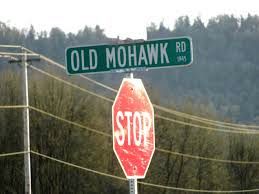 After visiting a friend and looking at her new horse, Diane and her kids went for a drive; not at all unusual for this family not living according to middle class rules. When the young ones fell asleep in the car, their mother decided to head home.
After visiting a friend and looking at her new horse, Diane and her kids went for a drive; not at all unusual for this family not living according to middle class rules. When the young ones fell asleep in the car, their mother decided to head home.
She saw a man on the road and stopped thinking he needed help. According to Diane, he shot her kids, she struggled with him and managed to escape after getting shot.
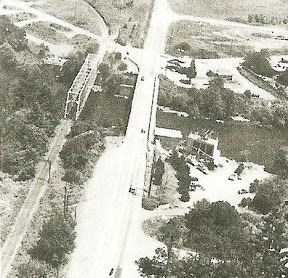 Aerial view of crime scene |
In the nurse’s notes, she is described as in shock and unable to grasp the situation. Most people described Diane’s injury as minor or superficial but in reality, it was a very serious injury. Her arm was severely damaged, so shattered that she needed a graft from a hip bone. A steel plate had to be attached and some lead fragments were removed.
Her children were obviously more severely injured because being captive in the car while a shooter aimed at them gave them less of a chance to wiggle out of the situation than an adult outside the car.
Diane’s injury had to be quite painful and she had to be in shock while driving to the hospital and accompanying the detectives to the crime scene. So how she behaved at the time, should not have been a factor influencing the authorities. But her behavior became the most important factor in the investigation that followed.
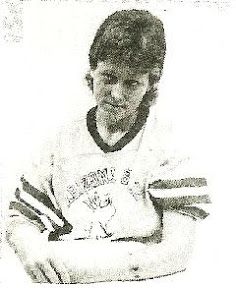 Diane Downs' bullet wound exposed |
The Investigation
The detectives took Diane to the crime scene and were able to retrieve shell cases on the ground where the incident happened. But strangely, they took no photos of the crime scene and did not lift fingerprints from the car.
Diane’s automobile was secured and examined and no gun was found. She also underwent a gun residue test that same evening that revealed that she had not held or shot a gun. She had no blood spatter or gun powder residue on her hands, clothing or hair. Meaning, she could definitely not have been the shooter.
 This is blood splatter on the car's headliner. |
It takes a very deep scrubbing with soap and water to get rid of gun powder residues and a little wash with one hand would not do the trick. Plus, Diane could have never cleaned her clothes and her hair to remove blood and gun powder. So that theory does not hold water.
"Gunpowder is one of the toughest stains around, when it comes to removing it from clothes. The fact that – if it gets on your skin – it is like being given a tattoo, should give you some idea what a tough stain it is. Washing soda is your best bet: It includes, among its ingredients, the exceedingly corrosive carbolic acid. If you use this mixed water, you can lift off a gunpowder stain."
The Bushy Haired Stranger
Diane described the stranger that shot them on the road and a police artist came up with a sketch. DA Pat Horton declared early in the game to the local paper that ‘the search for the bearded stranger was not very high on their priority list.’
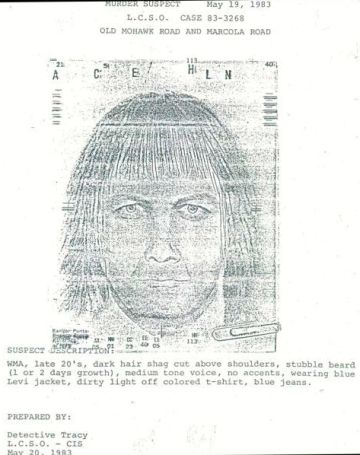 Diane Downs described this man to police |
To the authorities, it was a ridiculous notion that they would not entertain so they did not follow on numerous leads coming from people who had seen someone corresponding to that description.
They already had made up their mind that Diane was the perpetrator so they laughed off the idea of the ‘bushy haired stranger.’ The problem was that they could not find the gun anywhere and they had nothing on Diane.
Teams of people and detectives combed the area for months looking for the gun but it was nowhere to be found. Even prosecutor Fred Hugi was seen walking the grounds to try to find the weapon. They were in a difficult situation because without evidence, they could not charge her for the crime. Yet in their mind, she was already guilty.
Sheriff’s Deputy Roy Pond admitted in court that he had already concluded that Diane was guilty and stopped following leads on the orders of his sergeant three weeks after the shooting.
Almost from day one, Diane was perceived as a ‘cancer’ they had to remove. They did not like her attitude and she did not behave the way they expected a grieving mother to act. So it was a relentless game to try to reel her in.
She was fighting back and they did not like it. So they did everything in their power to slant the media and the public in their favor.
This case had many similarities to the Alice Crimmin’s story. An attractive woman whose two children were killed in mysterious circumstances and the cops decided to go after her. They hated her attitude and thought she was promiscuous and showed no sorrow or remorse. Instead of grieving, Alice went partying and had sex. They finally charged her and she did 10 years for the death of her children. To this day, there is not enough evidence to prove her guilt or innocence for that matter.
Not unlike Diane, Alice did not want to share her pain in public. They both fainted when they saw their dead child, but it did not count. The authorities wanted to see them mourn and fall apart. But these women did not show emotions and did not fold when asked to. And these men in black perceived this as an act of war. And they proceeded to go after them with every legal or illegal means at their disposal.
The best policy for Diane Downs would have been to remain silent, but she fought back and smiled at the wrong time and according to them, enjoyed the attention. It did not matter that they had no evidence; they did not like her attitude and she was going to pay for it.
The two mental disorders that cause excessive talking are Bipolar Disorder and Schizophrenia. If Diane was bipolar, the non-stop chatter would be part of the deal. And the flat affect and sometimes inappropriate smiling would come with the territory so you cannot judge her actions without taking into account that she might not have been acting according to the norms, but it had nothing to do with the evidence of the case. But it is useless labelling anyway.
8-Year Old Christie Downs
 Christie |
Christie could not speak, but after some rehab she kept saying she did not know who shot her or her siblings.
The powers that be knew they had nothing on Diane so little Christie became their sacrificial lamb. But to convince this little girl to turn on her mother, they needed to isolate her from her family and work relentlessly on her ‘confession.’
Even Ann Rule in her book, keeps mentioning that they only had a few months to get Christie to talk, otherwise they could not keep her away from her mother any longer.
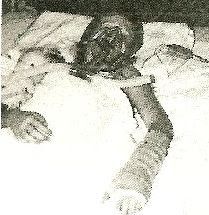 Christie Downs in the hospital |
Three weeks after the crime, Judge Foote from family courts, removed Danny and Christie from the care of Diane Downs and her family. Even if the nurses’ notes indicated countless times that the children asked for their mother and enjoyed her visits, they cut them off from the only family they knew and loved; supposedly for their own protection.
 Cheryl |
In fact, Diane and her lawyer wanted Christie to be able to heal before being questioned and to be accompanied and taped during the sessions. A very reasonable request that was rejected. It became judicial kidnapping to obtain a coerced confession.
Christie was only eight, had suffered gunshot wounds and was in shock. She had a stroke and was treated with mood altering Dilantin before and after testifying.
She had been isolated from her whole family and being unethically interrogated. It was not unlike brainwashing. Every time, she said she did not know, they told her to think again and made suggestions. And the interrogations were not taped and were barely documented.
The unreliability of children’s testimony has been documented by cognitive psychologists such as Elizabeth Loftus of the University of Cornell and others.
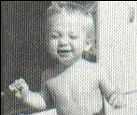 Danny |
There is no way that a jury would convict Diane today, based on the clearly coached testimony of Christie.
And the fact that she and her brother Danny were eventually adopted by Fred Hugi who prosecuted Diane Downs is the most blatant case of conflict of interest I have ever heard of.
It took months to get Christie to say that her mother was the culprit ant that is when they arrested her. Everything was in the bag and ready for trial.
The Trial
From the very beginning, the DA’s office had their ducks in a row because in an unprecedented move, Judge Gregory Foote who had denied access to the children by all blood relatives and given their care over to the State, was promoted from ‘juvenile’ to ‘senior’ judge to preside over the trial of Diane Downs.
 Judge Foote |
Diane’s father, Wes Frederickson, had hired an ex-Prosecutor to defend his daughter and his name was James C. Jagger. It turned out to be a mistake because he was married to a County Circuit Court Judge who would become a colleague of Foote and he had no intention of defending Diane vigorously. You wondered at times, which side he was working for.
Mr. Frederickson must have had a bad feeling about Jagger because before trial, he tried to retain defense attorney Melvin Belli who had the reputation of fighting for his clients and to win all his cases.
Belli filed a motion for a 3-week extension to familiarize himself with the case and declared Diane innocent in a press conference, but Foote denied the motion and declared "you have an attorney, use him."
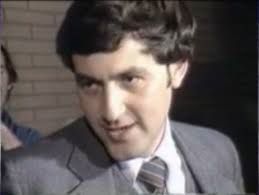 Prosecutor Hugi |
Diane’s brother sat in court one day and saw Foote looking at Hugi before ruling on an objection. The prosecutor would gently shake his head and Foote would follow with a ruling.
Foote refused 30 to 50 reports by detectives of sightings or leads about the shooter but admitted reports from people in Arizona willing to badmouth Diane. It was rigged and the fact that Ann Rule sat in the courtroom ready to produce a Masterpiece of Guilt could only help the prosecution.
The Gun
According to the State, ballistics evidence proved that Diane Downs was guilty. They claimed to have found two lead cartridges in Diane’s rifle after the shooting but there were discrepancies. The tool marks did not match and the detective lied on the stand.
During closing arguments, Fred Hugi mentioned the Ruger model number and said he had the bill of sale, but it turned up at a police raid years later in Perris, California where a detective involved in the case, Dick Tracy, had been employed prior to his move to Oregon. The gun did not match the ballistics from the shooting site. Ruger #14-76187; Diane’s gun, was not the murder weapon. They tried to come up with another story to explain that it was not the gun after all but the jig was up.
It was proven in court that the shooter had to be left-handed to have been able to shoot the kids in the car at the right angle and Diane was right-handed. Hugi had to come to this realization during a demonstration at trial.
Fingerprints at the crime scene were suppressed by the State.
Police witness reports of strangers and confessions were suppressed or not pursued.
Years later, seven witnesses signed affidavits telling of a man named Jim Haynes’ continuing confession that he was the shooter, and he physically resembled the sketch.
Diane’s Mental State
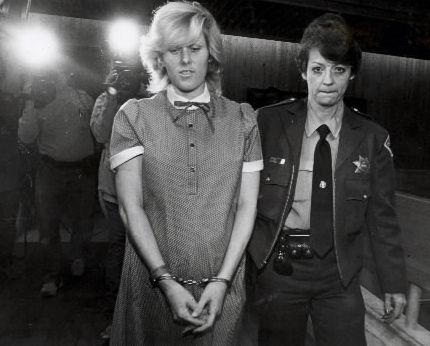 Arrested in 1984, Diane was pregnant with her fourth child. |
In fact, Diane had consulted a psychologist after the tragedy and after months of consultation, she was never diagnosed as a sociopath. The definition of ‘deviant sociopath’ does not even exist in the DSM-HI, which is the official psychiatric diagnostic manual. She did diagnose her as suffering from cyclothymic disorder and treated her accordingly. She signed an affidavit to that effect and wanted the jury informed of it but it was never done.
As soon as Diane was found guilty, Hugi demanded that Diane be evaluated by a psychiatrist before sentencing so they could declare her a dangerous offender and give her a stiffer sentence.
Strangely enough, a woman who was seen for 8 months by a psychologist and declared to be in shock, would now be assessed by the ‘State hired psychiatrist’ to confirm the label Hugi conveniently made up during trial. And Hugi seemed pretty sure he would get what he was asking for.
So when Dr. George Suckow from the Oregon State Hospital in Salem was called as a State’s rebuttal witness and he made a professional diagnosis of Diane as histrionics, antisocial and narcissistic, he openly said in court that he interviewed Diane for 1 hour and read evidence presented by the state to make his diagnosis.
It gave Ann Rule carte blanche to use these labels in her book and it stuck. Diane was now labeled as a dangerous offender. Mission accomplished.
The Unicorn and Hungry Like the Wolf
Ann Rule made a big deal of a brass unicorn engraved with the children’s names that Diane had purchased. It was omnipresent in the courtroom as well as the Duran Duran song Hungry like the Wolf that supposedly was playing when the children were shot in the car.
According to Rule and the court, the unicorn was a memorial to her children that she purchased after premeditating their murder. It was far-fetched, unfounded and entirely made up by Rule to boost the sales of her book.
There is absolutely no evidence that Hungry like the Wolf was playing when Christie got shot but it is another detail they added to bring a dramatic element to this trial. They played the tape in the courtroom, and the fact that Diane did not break down but tapped her foot to the music, was supposed to be another proof of her guilt. Only in Hollywood and in Ann Rule’s books, would you find such fantasy.
 In fact, if someone was Hungry like the Wolf in this courtroom, it was a certain crime author who could already smell and taste the fortune coming her way after the publication of this juicy story.
In fact, if someone was Hungry like the Wolf in this courtroom, it was a certain crime author who could already smell and taste the fortune coming her way after the publication of this juicy story.
Fred Hugi was pretty upset when Ann Rule went Hollywood with his case. I am convinced that he did not want too many people to know about the improprieties that happened in his courtroom. But he overestimated the kind of people that would go along with this soap opera. They were not truth seekers and enjoyed a nice burning at the stake instead.
Rule defended her right ‘to earn a living’ and to tell her story. Too bad she did not interview Diane or her family. She talked to Diane for 15 minutes, there was the bizarre and partial Oprah interview that was basically a ‘let’s bash Diane’ event and she wrote to Diane in jail to ask her what she thought of Hugi adopting her children. That was the extent of her ‘investigation’ of Diane’s side.
When Diane’s youngest daughter grew up and reached out to her mother, the media and Rule grabbed hold of her and made sure she would hear nothing good about her mother. Rule even talked about writing a book about her but it never materialized. It probably was not impactful enough for readers.
The Foreseeable Verdict
Diane was cooked the minute she walked in that courtroom. Evidence or not, they were going to do their best to put her away for life. And their plan worked. The poor jury went along and Jagger did not put much of a defense anyway.
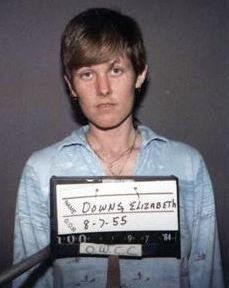 Diane Downs, prisoner |
Considering the lack of evidence, it seems that she was thrown to the wolves because of her personality. Christie became the star witness against her mother and who could resist such a touching testimony? Her lover and former husband testified against her but it did not represent evidence but character assassination. They had to create this monster as they had no concrete evidence.
There was never a real motive for the crime even if the State insisted that Diane wanted to be free to pursue her love interest. Why would she have driven the kids to the hospital then? And she knew that Knickerbocker hated trouble so he would not have come back to her after an ugly shooting where she had been wounded and her kids damaged.
I do not care if the bushy haired stranger made no sense or if they could not explain the why of the tragedy, I do not care if she was madly in love with a guy because all that counts is proof and evidence in a court of law, and there was definitely a reasonable doubt. Without the media blast and rush to judgment from the police and DA’s office, we might have uncovered the truth.
The Aftermath
Years later, Christie was heard saying by classmates that she did not know who shot her. There is also a recording where she says that she had no idea who shot them. The tape is real and probably not admissible but it proves that her testimony was coerced.
Caught in the act, Hugi declared that Christie said that only because she was pressed for an answer. Of course, because this is what she does when people ask her questions concerning her mother. After all, she was conditioned this way.
Diane was found guilty and sentenced to life and she has been in prison ever since. She was in solitary confinement for years and even escaped from prison once but was recaptured.
In 1999, a Board Certified Psychiatrist practicing in Oakland, California wrote a letter to the parole board on behalf of Diane Downs to explain how things had changed since 1984 when she was diagnosed with a ‘severe personality disorder.’ He did not consider her a risk factor at all and believed she would do well if released into society, because she had no prior history of violence and never had a problem with violence or bad behavior while incarcerated.
In 2008, a psych evaluation by L. Williams, Ph.D., Chief of Mental Health at Valley State Prison for Women, explained Diane’s lack of emotions and its relationship to her case.
"Ms. Downs makes every effort to avoid emotional stimuli in order to reduce the demands made on her. She functions best in highly structured environments where she has a sense of control. She may be highly vulnerable to losing control of her emotions in emotionally charged situations, creating faulty judgment and ineffective and inappropriate behavior.
"She keeps her emotions under tight control, presenting only socially acceptable feelings and burying other contradictory feelings."
As far as her innocence goes and the possibility of being paroled if she admitted her crime, Diane strongly maintains her innocence.
She states, "I did not shoot my children and I can’t say I did. It would not benefit you, my children, or society for me to perpetuate that lie.
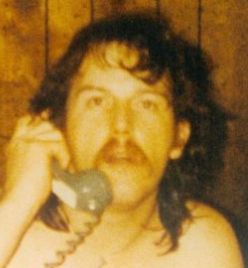 Haynes bragged about the killing. |
She goes on to say that she has deep regret and mourns the loss and death of her children.
If it was not such a high profile case, Diane Downs would have been paroled a long time ago, considering her good behavior and lack of priors.
The Parole Board had an obligation to parole Diane between 1998 and 2002 if she could provide reasonable cause to show she was not a danger to society. According to Oregon law, this would have to be supported by a psychiatrist’s report or a Wardens’ letter and Diane provided both. But the Parole Board refused to hear her.
She followed all the correct Parole Board procedures for two years with no hearing. She then went through the State (Circuit) Court habeas corpus relief for four years to no avail. She is nowhere near being paroled and if she admitted guilt, I am not even convinced they would release her. Her case was too public and they are afraid of public backlash.
I do not know what happened on Old Mohawk Road on that dark evening, but I know that they did not have enough evidence to try and convict Diane Downs. They should have taken their time to investigate this case thoroughly and without prejudice.
Diane Downs and Alice Crummins were considered sluts and cold-blooded women and were judged on their unusual character. The lousy men in their lives never took a hit because after all, it was these witches’ fault.
It is ironic that you have to be a perfect mother with no lovers to be considered innocent until proven guilty in America.
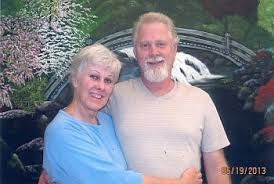 Diane and brother James, 2013 |
A trial should be based on evidence only and Diane Downs was condemned because of her flaws.
She has done her time in prison and I hope that she gets the chance to get out and spend time with her aging parents and siblings who have been fighting relentlessly for her release.
Ann Rule might have inflamed the case with her book Small Sacrifices and her theory of the crime, but in reality, the case of Diane Downs was no small sacrifice.
The price of celebrity for her was losing her freedom and her children for life. It does not get any bigger than this.
Special thanks to Lise LaSalle, All Things Crime. Article previously published here: http://www.allthingscrimeblog.com/2014/07/22/the-diane-downs-case-was-no-small-sacrifice/
Previous articles about Diane Downs on Salem-News.com
Nov-18-2013 BIG SACRIFICES: A Consideration of Flawed Forensics Used to Convict Diane Downs (AUDIO) - Salem-News.com
Nov-13-2013 Father of Diane Downs Remains Vigilant After 30 Years (VIDEO) - Tim King Salem-News.com
Jul-15-2013: Midnight Meditations: A Visit with the Frederickson Family - Dr. Thomas Arthur Billings
May-20-2013: EXCLUSIVE: Diane Downs Never Held a Weapon, How Could She Have Shot Her Kids? - Tim King Salem-News.com
Apr-17-2013: Midnight Meditations: Diane Downs Murder Case in Oregon - Dr. Thomas Arthur Billings
Aug-17-2012: Diane Downs: Child Killer or Victim of Injustice? - Tim King Salem-News.com
Dec-10-2008: Diane Downs Denied by Oregon Parole Board - Salem-News.com
 |
Articles for August 2, 2014 | Articles for August 3, 2014 | Articles for August 4, 2014
Quick Links
DINING
Willamette UniversityGoudy Commons Cafe
Dine on the Queen
Willamette Queen Sternwheeler
MUST SEE SALEM
Oregon Capitol ToursCapitol History Gateway
Willamette River Ride
Willamette Queen Sternwheeler
Historic Home Tours:
Deepwood Museum
The Bush House
Gaiety Hollow Garden
AUCTIONS - APPRAISALS
Auction Masters & AppraisalsCONSTRUCTION SERVICES
Roofing and ContractingSheridan, Ore.
ONLINE SHOPPING
Special Occasion DressesAdvertise with Salem-News
Contact:AdSales@Salem-News.com

googlec507860f6901db00.html



Terms of Service | Privacy Policy
All comments and messages are approved by people and self promotional links or unacceptable comments are denied.
Caroline February 2, 2022 7:58 pm (Pacific time)
Did an eighth grader write this story? It's riddled with cliche, with grammar mistakes, run-on sentences. If you criticize the book by Ann Rule (and I do as well), at least make strong arguments.
Sky February 9, 2021 12:16 am (Pacific time)
Unfortunately, your own article is full of false statements and suppositions. Was Ann Rule sued for writing the book about Diane Downs? Or the film makers for making the film? Of course not. And anybody can sue anybody for anything, using that case which has Nothing to do with the story you segue into, is about as disingenuous as it gets. You tried to smear Rule's integrity, but it only backfired. And I see a police officer has already schooled you on gun powder residue and your incorrect idea on how that works.
Kimberly April 3, 2020 10:11 am (Pacific time)
Are you serious with this article? Seems you conveniently forgot one important fact... her surviving daughter said it was Downs who shot her? Today's court of law or yesterday's court of law, let's see you get around that!
EDITOR: Please refer to the article: "Christie was only eight, had suffered gunshot wounds and was in shock. She had a stroke and was treated with mood altering Dilantin before and after testifying.
She had been isolated from her whole family and being unethically interrogated. It was not unlike brainwashing. Every time, she said she did not know, they told her to think again and made suggestions. And the interrogations were not taped and were barely documented."
Anonymous October 3, 2019 1:35 pm (Pacific time)
Americans just hate women, particularly mothers, and jump at any opportunity to ruin their lives. U.S. prisons are full of wrongfully convicted women, many of them mothers falsely accused of killing their children. It's a disgrace but a fact of life in this misogynistic country.
Jake Sugarman April 11, 2019 11:54 am (Pacific time)
Diana Downs is the most guilty person ever. I cannot believe there are some idiots who believe she is innocent!!!!
charlotte April 11, 2019 7:31 am (Pacific time)
This article is garbage. The evidence against Diane Downs is overwhelming. See what really pisses me off is there really ARE innocent men and women behind bars. And NO ONE takes them seriously because of nutcases like you who claim that guilty people are innocent. It's just wrong. Just plain wrong.
Barbara December 13, 2018 11:04 am (Pacific time)
Such a biased "article".
Jason August 19, 2018 4:34 pm (Pacific time)
Gunpowder residue isn't hard to remove, you don't even need to use soap. Anyone who's a recreational shooter can tell you that.
Max June 14, 2017 2:03 pm (Pacific time)
What a bunch of BS about Diane Downs!!!
Laurie November 6, 2016 8:48 pm (Pacific time)
First you say they never checked the car for fingerprints then you say the judge didn't allow fingerprint evidence from the scene to be admitted at trial. So which is it?
Bobbie October 12, 2016 2:39 pm (Pacific time)
You have a lot of good points here.
Soxie October 9, 2016 8:05 pm (Pacific time)
I stopped reading after the gunshot residue part. Having a background in law enforcement myself, simply smoking a cigarette can alter the effect of gunshot residue. That's why investigators make sure one hasn't smoked a cigarette, washed their hands, etc, because it will invalidate a GSR test.
Lee June 12, 2016 2:05 pm (Pacific time)
This is one of the most poorly researched and written articles I have ever read. SMH.
EDITOR: thank you for the correction, it has been made.
Becky December 9, 2015 1:18 am (Pacific time)
Darlie is innocent. Diane is not.
Diane Evans September 24, 2015 8:16 pm (Pacific time)
I have been following this story for decades. I don't care what an author did or Hollywood. The story does not fit the crime! This story reminds me of Darlee Routier! Why the hell would anyone begin shooting , helpless, sleeping children BEFORE they shot the only adult in that vehicle? None of this makes sense! And Diane is the only one who had a motive to kill those children! If anyone , YOU have made this a "story" and a "tall tale", not Hollywood or Anne Ruule! And it all comes down to the innocent words of the little girl who has to face this the rest of her life! I can not imagine what she could be going through today! Why don't you put your efforts towards the two that survived this evil crime??Diane is where she belongs!
severina September 1, 2015 2:59 pm (Pacific time)
Diane is a criminal with disorders in her personality,she was possibly borderline or suffering from schyzophrenia no doubt about that!she constanlty is in denial which means that she is mentally disturbed and insane..her daugter stayed alive i am very happy of that and could testify against her.Poor christie,dan and poor Rebecca her last daughter who was emotionally devastated when she learnt the truth and started to be depressed and use drugs until she sees her biological mother at eighteen who just told her "but Rebecca,you know i did nothing.."well that's denial and lack of mental stability. DIane is a personality disordered criminal and you shouldn't hold her in esteem..her children deserve love and esteem not her..sorry..
Darrell Lucus July 12, 2015 2:56 pm (Pacific time)
Northon's suit was actually thrown out by a federal appeals court because it violated Oregon's anti-SLAPP law. Plus, the original poster leaves out that there was no blood on the driver's side of the car. While it is highly questionable at best that Foote would be allowed to preside over both the child custody and murder trials, the rest of the post is bunk. Salem News should have been embarrassed to reproduce it.
Diana May 8, 2015 3:29 pm (Pacific time)
This would not be the first case involving a wrongful conviction. I feel sorry for entire effected family. Why don't people see that something is glaringly wrong here? The Prosecuting Attorney adopting the Downs children puts this case over the top.
Nancy April 24, 2015 7:36 am (Pacific time)
I remember all of this when it happened. I am incredulous that you would print such hogwash. It reflects badly on the quality of your reporting.
Anonymous April 22, 2015 11:30 pm (Pacific time)
I had to comment because this article was so atrociously written and conceived. Diane Downs and Liysa Northon are personality-disordered criminals held in bizarre esteem by the author - said author who, by the way, should rethink journalism as a profession. Just all-around horrible.
Rachel Billings April 8, 2015 4:06 pm (Pacific time)
My father's "Meditations"
to bonnie
My father is Dr. Thomas Arthur Billings and he died in 1995. His brother, Robert, died this January 1st in their ancestral home in Leaburg Oregon. I have been out to my uncle's house numerous times over the last few months, and during one of my last visits I picked up his copy of "Small Sacrifices" by Ann Rule. I remembered my father being very interested in the late 80's and early 90's about whether or not Diane Downs received a fair trial. He sent me his meditations and I read through them. I have now read Ann Rule's book which I had never done before. All my father's children were a little aghast when we learned of his interest in this case...I guess we thought as most people did...if her own CHILD said she did it..well she MUST be guilty. We had also learned to be a little skeptical of our father's curiosities, but I do remember reading his words and WONDERING...what if, what if...
Anyway, my question to you now is how you obtained my father's "Meditations". As far as I know they were never "published". I was visiting a web site after finishing Ann Rule's book to see where Diane is now and what is happening with her case. One of the sites that came up was the Salem-News and when I read the article and then scrolled to the bottom, there it was...Meditations by Dr. Thomas Arthur Billings that looked to be printed in your paper last year, along with the beginning of his obituary. He wrote those words over twenty years ago! I still have my own copy, along with a lot of correspondence from Diane to my father, as he would visit her in jail and she wrote to him often. Did SHE give them to you? Did her father, Wes? Can you let me know? I would appreciate your response.
Sincerely,
Rachel Billings
Editor: Hi Rachel, I am very glad to hear from you. Diane's dad, Wes, and her brother, James, gave us the link to your dad's writing on the subject, http://www.midnightmeditations.com/. We respect his work very much, and I'm happy that you've found our site. If you would like to discuss further, please email me directly: bonnie@salem-news.com
All the best,
Bonnie
Susan Murphy August 5, 2014 8:09 am (Pacific time)
Elizabeth Loftus is not at Cornell. She does research with adults, not children.
[Return to Top]©2025 Salem-News.com. All opinions expressed in this article are those of the author and do not necessarily reflect those of Salem-News.com.